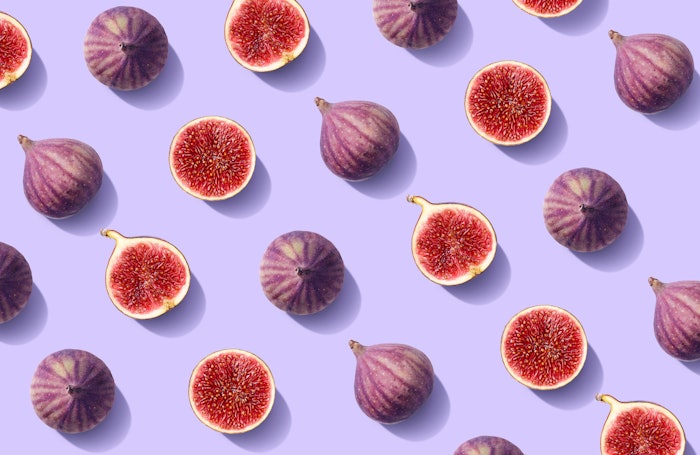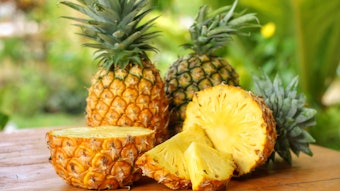
I am not often enthusiastic about trivial chemical names. They often lead to confusion. It would be nice to imagine that the chemist who came up with the names, caproic acid, caprylic acid and capric acid had a magnificently malevolent sense of humor. I suspect the truth is much more mundane. The names were all variations on the Latin word for goat.
4-Hydroxy 2,5-dimethyl-3(2H)-furanone (FEMA #3174, CAS #3658-77-3, COE #536, DG SANTE #13.010) is a notable exception. This chemical is so important in the flavor industry that it has been given many trivial names. Furaneol is far and away the most widely used and is not remotely capable of confusing.
Furaneol is found so widely in nature that it is hard to know where to begin. There are two broad categories. The first is fresh fruit flavors, led by pineapple and strawberry, which it can form an important part of the profile. The second relates to any food that has been heated.
The strong relationship between furaneol and other candy notes is complicated. The most important is maltol. On a good day, Furaneol is twenty-five times stronger than maltol, but in some flavors, the strength relationship is much lower. Maltol enhances furaneol, which complicates things further.
Furaneol, like maltol, has the effect of enhancing the perception of sweetness, which adds to its utility. This subject is so expansive that, to do it justice, I have split it up, looking at fruit flavors first.
Note that the dose rates given throughout this article are the levels suggested for use in flavors intended to be dosed at 0.05% in ready-to-drink beverages or in a simple bouillon.
Fruit Flavors
Acai: Furaneol adds a pleasant background sweetness to acai berry flavors at around 100 ppm.
Apple: The effect of apple flavors is also to provide depth and background sweetness. The ideal level of addition is similar, around 50 ppm.
Apricot, Hakuhou, Nectarine and Peach: Higher levels, in the region of 500 ppm, are more effective in this group of orchard fruit flavors.
Banana: Furaneol is an optional ingredient in banana flavors, but 20 ppm adds a pleasant taste effect.
Blackberry: Levels vary in concert with the level of musk notes, but 1,000 ppm is a good starting point.
Blackcurrant: Levels also vary in blackcurrant flavors, starting at 500 ppm in traditional-style flavors. More authentic, fresh styles can accommodate much higher levels.
Blueberry: Very similar comments apply to blueberry flavors, with levels ranging from 200 ppm to 2,000 ppm.
 Authentic melon flavors, irrespective of style, work best with modest levels, around 100 ppm. More fantasy, watermelon, oriented flavors can use levels up to 2,000 ppm.Adobe Stock
Authentic melon flavors, irrespective of style, work best with modest levels, around 100 ppm. More fantasy, watermelon, oriented flavors can use levels up to 2,000 ppm.Adobe Stock
Cherimoya: Authentic cherimoya flavors benefit from around 100 ppm of furaneol.
Cherry: Similarly, all styles of cherry flavors are enhanced by furaneol. Levels vary, but 200 ppm is typical.
Cranberry: Similar levels are also effective in cranberry flavors.
Dragonfruit: Furaneol works well in dragonfruit flavors at 50 ppm, adding a subtle sweetness.
Durian and Jackfruit: One hundred ppm of furaneol helps to build the soft aroma and taste background to mitigate the dramatic sulfur notes.
Elderberry: Elderberry flavors are a minor category, but furaneol plays an important role at levels in the region of 1,000 ppm
Fig: Fig flavors are another minor category, but furaneol is even more central to the profile. Eight thousand ppm works well.
Grape: Levels vary dramatically in grape flavors, but the most important category, Concord grape, needs around 1,000 ppm.
Grapefruit, Orange and Lemon: Grapefruit, orange, lemon and other citrus flavors are not obvious homes for furaneol. However, adding a hint of this ingredient, from 2 ppm to 5 ppm, enhances the effect of juice as opposed to peel.
Guava: Furaneol is important in guava flavors. Levels start at 2,000 ppm, but the sky’s the limit.
Kiwi: Despite the delicate nature of kiwi flavors, 1,000 ppm of furaneol is not overdone.
Loganberry: Although musk notes are minimal in loganberry flavors, the level of furaneol can be higher than in blackberry flavors, up to 1,500 ppm.
Lychee: Fifty ppm forms an attractive backdrop to the rose notes in lychee flavors.
Mango: High levels of furaneol, from 1,000 ppm to 2,000 ppm, dominate the foundation of mango flavors.
Mangosteen: Similar levels are equally effective in mangosteen flavors.
Melon: Authentic melon flavors, irrespective of style, work best with modest levels, around 100 ppm. More fantasy, watermelon, oriented flavors can use levels up to 2,000 ppm.
 Fifty ppm forms an attractive backdrop to the rose notes in lychee flavors.Adobe Stock
Fifty ppm forms an attractive backdrop to the rose notes in lychee flavors.Adobe Stock
Passionfruit: The level in passionfruit flavors is quite subject to creativity. Realistic levels are around 500 ppm, but much higher levels can be very attractive.
Pear: Pear flavors do not need an obvious background foundation, but 50 ppm of this ingredient rounds out the taste significantly.
Pineapple and Strawberry: These two flavors can be considered together because furaneol forms a key part of their character recognition skeleton and ideal levels are very high, around 10,000 ppm. These high levels pose two important challenges. One is the cost. This can be offset to a degree by adding Maltol. The two chemicals exhibit a mutually enhancing effect and allow some reduction in the level of furaneol. The other challenge is stability. Furaneol is susceptible to oxidation, giving rise to off-notes with a fenugreek odor, which is offensive in fruit flavors. In some applications with a long shelf life, this can be a noticeable problem. Ascorbic acid reduces but does not always eliminate the off-notes. One fairly effective solution is to use ethyl furaneol, which is three times stronger and significantly more stable. Wild strawberry flavors are an interesting sub-group within strawberry flavors. They differ from most other strawberry flavors in many respects. The most important are the higher levels of methyl jasmonate, and methyl thiobutyrate, along with a generally lower level of furaneol.
Prune: High levels work well in prune flavors, where the effect is a combination of the level in the original fruit added to the level caused by drying. Additions vary radically, starting at 1,000 ppm.
Raisin: Raisin, along with Rum and Raisin flavors, only need a small addition, around 20 ppm.
Raspberry: Raspberry flavors seem to be a very coherent category, but they actually embrace significant variations. The most significant is the level of the violet note, which can be noticeably exaggerated. Furaneol can counterbalance this effect, so levels of addition range from six hundred to two thousand ppm.
Starfruit: Furaneol plays a modest part in realistic starfruit flavors. Two hundred ppm is a good starting point.










